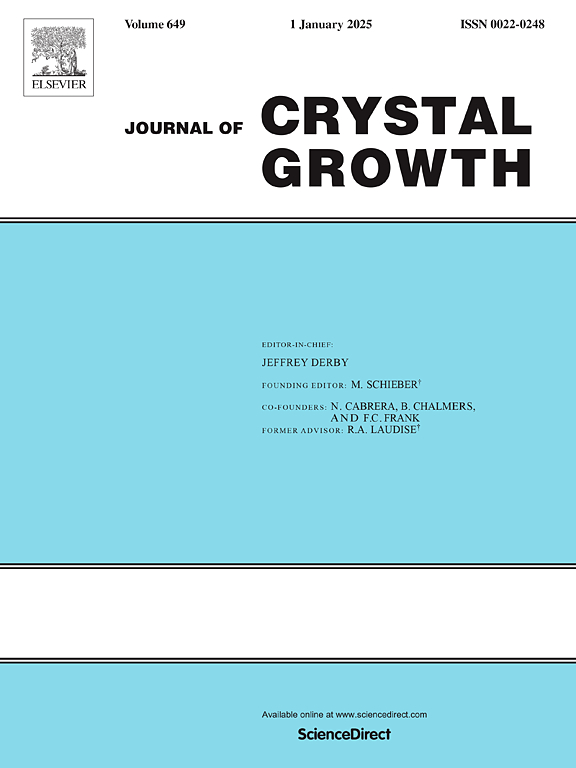一种改进的微观元胞自动机模型用于模拟镍基高温合金凝固/熔化过程中的组织演变
IF 1.7
4区 材料科学
Q3 CRYSTALLOGRAPHY
引用次数: 0
摘要
建立了定量修正的微观元胞自动机模型(CA),模拟了IN718镍基高温合金凝固/熔化过程中的组织演变。与原CA模型相比,改进的CA模型具有溶质守恒和固有的熔融/凝固算法结合的优点。该模型受扩散界面模型的启发,优化了扩散和溶质重分布,并在计算域内实现了限制的溶质守恒。根据过冷值采用KGT (Kurz-Giovanola-Trivedi)模型计算凝固/熔化动力学。在测试了改进CA模型的栅格尺寸独立性和栅格各向异性后,应用该模型模拟了不同冷却速率下IN718合金的多轴枝晶和柱状枝晶的生长,量化了溶质Nb在液相中的偏析。结果表明,在凝固过程中,随着冷却速率的增大,Nb的偏析逐渐减弱。在得到凝固的枝晶后,用改进的CA模型直观地模拟了等温保温过程中枝晶的粗化过程。模拟结果有效地模拟了由凝固机制和熔化机制共同影响下的粗化行为,这是原始CA模型无法再现的。本研究为在实际工程事故中更好地了解镍基高温合金凝固和熔化过程中的组织演变机制提供了一个强大的工具,计算效率高。本文章由计算机程序翻译,如有差异,请以英文原文为准。
A modified microscopic cellular automaton model for the simulation of microstructure evolution during solidification/melting of nickel-based superalloys
A quantitatively modified microscopic cellular automaton model (CA) is established to simulate the microstructure evolution during solidification/melting of IN718 nickel-based superalloys. As compared to the original CA model, the modified CA model has the merits of solute conservation and the inherent incorporation of the melting/solidification algorithms. Inspired by the diffuse interface models, the present model optimizes the diffusion and solute redistribution, and the solute conservation within the computational domain is achieved restrictively. The KGT (Kurz-Giovanola-Trivedi) model was used to calculate the solidification/melting kinetics according to the undercooling values. After testing the grid size independency and grid anisotropy of the modified CA model, it was applied to simulate the growth of multiequiaxed and columnar dendrites of the IN718 alloy under different cooling rates, and the segregation of solute Nb in the liquid phase was quantified. The results reveal that the segregation of Nb was weakened with higher cooling rates during solidification. The simulation of dendritic coarsening during isothermal holding was carried out by the modified CA model in a straightforward manner after the solidified dendrites were obtained. The simulation results effectively mimicked the coarsening behavior driven by the coherent influences of solidification and melting mechanisms, which were uncapable to be reproduced by the original CA model. This study provides a powerful tool with high computation efficiency for better understanding the microstructure evolution mechanisms in nickel-based superalloys during solidification and melting in practical engineering incidents.
求助全文
通过发布文献求助,成功后即可免费获取论文全文。
去求助
来源期刊

Journal of Crystal Growth
化学-晶体学
CiteScore
3.60
自引率
11.10%
发文量
373
审稿时长
65 days
期刊介绍:
The journal offers a common reference and publication source for workers engaged in research on the experimental and theoretical aspects of crystal growth and its applications, e.g. in devices. Experimental and theoretical contributions are published in the following fields: theory of nucleation and growth, molecular kinetics and transport phenomena, crystallization in viscous media such as polymers and glasses; crystal growth of metals, minerals, semiconductors, superconductors, magnetics, inorganic, organic and biological substances in bulk or as thin films; molecular beam epitaxy, chemical vapor deposition, growth of III-V and II-VI and other semiconductors; characterization of single crystals by physical and chemical methods; apparatus, instrumentation and techniques for crystal growth, and purification methods; multilayer heterostructures and their characterisation with an emphasis on crystal growth and epitaxial aspects of electronic materials. A special feature of the journal is the periodic inclusion of proceedings of symposia and conferences on relevant aspects of crystal growth.
 求助内容:
求助内容: 应助结果提醒方式:
应助结果提醒方式:


